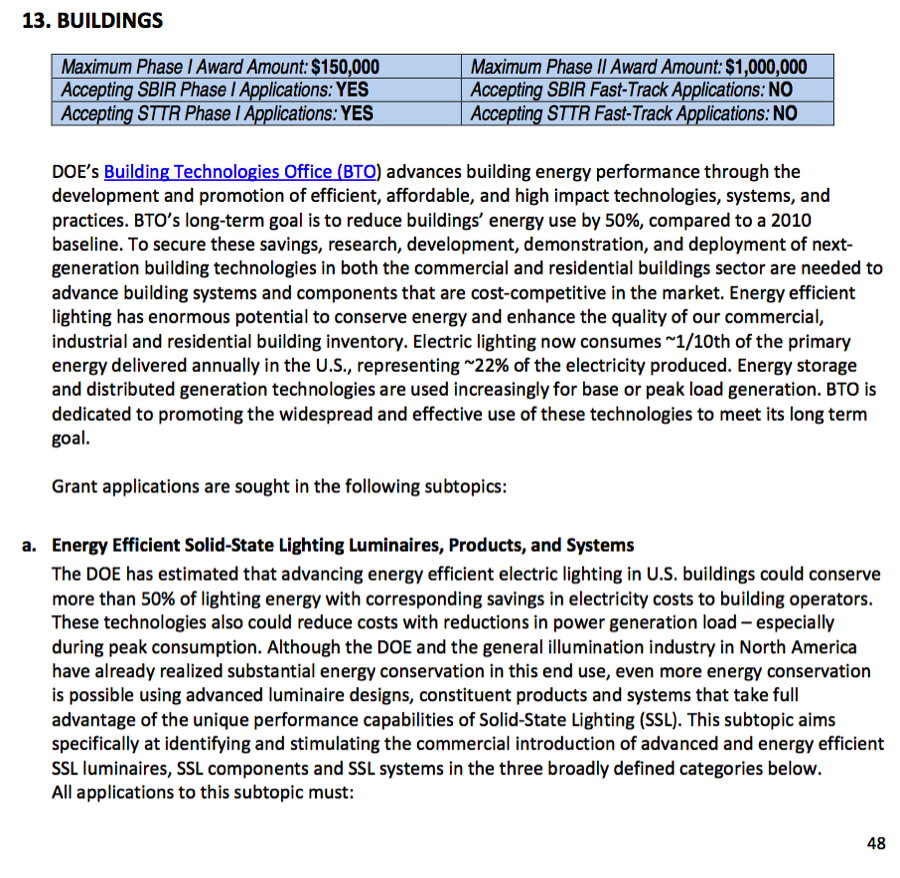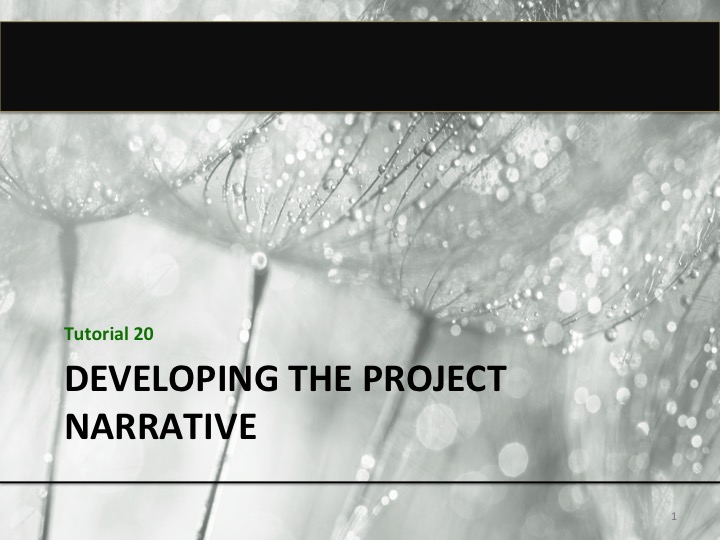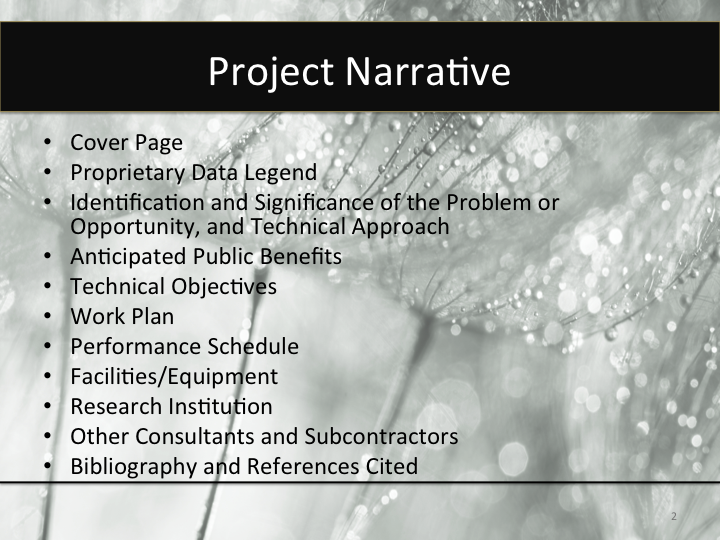Tutorial 20:
How do I prepare the project narrative?
The most important element of your response to a Department of Energy (DOE) Funding Opportunity Announcement (FOA) is the Project Narrative. Before beginning your work on this part of the application package, be sure that you are working from the most recent FOA, keeping in mind that DOE may update the FOA after its initial release. Therefore, always go back to the DOE website and download the most recent pdf. If you haven’t bookmarked the page on which this resides, then just type in “DOE SBIR FOA” in your browser and it will take you to the right location.
If you have submitted a DOE SBIR or STTR proposal in the past, don’t make the mistake of assuming that the structure of the project narrative will always be the same – as requirements are enhanced over time. To be safe, always go back to the FOA to affirm the structure, as the Funding Opportunity Announcement is the guiding document that trumps everything else. In preparing the Funding Opportunity Announcement DOE works hard to maintain consistency with the section headings. The Part that will be important to you is Part IV- Application and Submission Information, Part C – Content and Application Forms [Phase I Only]. Now that we have established the importance of the FOA, let’s explore the general sections of a responsive Project Narrative. The sections are listed in the accompanying screen shot
- Cover Page
- Proprietary Data Legend
- Identification and Significance of the Problem or Opportunity, and Technical Approach
- Anticipated Public Benefits
- Technical Objectives
- Work Plan
- Performance Schedule
- Facilities/Equipment
- Research Institution
- Other Consultants and Subcontractors
- Bibliography and References Cited
Please note that the following discussion is strictly from a proposer’s perspective and outlines an approach for developing a responsive project narrative. Proposal writing can be an exciting undertaking if you allow yourself time to be creative and to contemplate different approaches to solving the Department of Energy’s challenges. I therefore always start with the item in the preceding list called the Identification and Significance of the Problem or Opportunity and Technical Approach. In this Tutorial I will address only this section. Start with the assumption that the list of DOE topics represents areas of keen interest to the Department of Energy. Your priority at this point is therefore to assure that you learn as much as possible about that topic and why it is important to the Department of Energy. Let’s examine how you could expand your understanding of a topic and subtopic. I’m going to use a specific topic from a previous FOA as an example – Topic 13a. In looking at the topic description, I notice that DOE has provided a hyperlink to the Building Technologies Office and navigate to that page.
Sample Excerpt from FOA

Be sure explore the various sections of the Building Technologies Office or BTO website and look for documents and projects that relate to some of the metrics identified in the topic description. After having explored this site and bookmarked areas of interest, begin to search for key phrases taken from the topic description such as “BTO’s long-term goal is to reduce building’s energy use by 50%”. As it turns out this is a direct quote from the BTO website. Another strategy is to search for the topic author’s name in combination with a key word such as SSL or luminairs taken from the subtopic. More often than not this will yield one or more PowerPoint presentations given by the author. Finally, search for the technology name – in this case – SSL- in combination with the phrase “technology roadmap” and BTO. This strategy also yielded a meaningful document – the “Solid state Lighting R&D Manufacturing Roadmap”. By using this approach within less than an hour I will have found a wealth of information regarding the interests of the Department of Energy. Let’s explore how you would then use this information.
In a review of successful DOE proposals, the section entitled “Identification and Significance of the Problem or Opportunity, and Technical Approach” averaged three pages in length. The first part of this section commonly presents the case for the Problem or Opportunity; while the balance is used to highlight the technical approach of the applicant. In drafting that first section reference the topic and utilize what you have learned from your DOE related search to frame the problem and to demonstrate that you understand your immediate customer’s need – that is DOE’s needs. That said, the discussion of the problem or opportunity can extend beyond what DOE has stated to issues discussed in the literature at large. It may be helpful to insert a subsection in the outline called “The Technical Problem Addressed”. Once this section has been written then move on and begin the discussion of your technical approach.
The subsection entitled technical approach not only describes the approach that will be taken to address the identified problem/opportunity, but must also clarify what will be gained from funding your approach as opposed to an alternative. In other words, it is important to clearly identify the benefit that will accrue to DOE as a result of funding what you propose? This is accomplished by clarifying how your method will advance or address the identified topic. It is inappropriate to have this section be nothing more than a list of features of what you have already accomplished. Remember that both SBIR and STTR awards are made to small businesses to conduct innovative research. Certainly the research can build upon what you may have already accomplished – but the focus should be to address the DOE topic of interest while also addressing areas of interest to you. Keep in mind that you will discuss the objectives and specific tasks to be undertaken in subsequent sections. Therefore, the discussion of the technical approach should provide a general overview of the methods you will use, the expected outcomes, and the benefit to your immediate R&D customer – DOE.
You may find it easiest to separate the technical discussion into the following subsections
- Current methods used to address problem
- [Company name]’s Technical Approach
Preparing and writing this section often takes the most time – as it is the cornerstone for everything else that follows.
Once the preliminary research on the topic has been accomplished – it is fairly easy to begin writing the next section entitled Anticipated Public Benefit. The Department of Energy frequently states the public benefit of the research that it is undertakes – so if you have done your background research well– this section will be fairly easy to begin. However the FOA also asks that you identify specific groups in both the commercial and Federal Government that will benefit from your work; that you identify the product or process that will result and; that you talk about the significance of the market. To assure that you address these points sometimes companies add subheadings to make it easier for reviewers to see that they have identified all of these points.
You have done a good job today having completed about a quarter of the Project Narrative. Set your work aside for the day and work on something else. Let your ideas percolate overnight and then begin work on drafting the next sections when you resume. At this point you will have accomplished a draft of a key section of the Project narrative. If you have not taken the opportunity to speak with the Topic Manager yet, please review Tutorial 5 on how to speak with a Topic Manager and make sure that you call him or her to assure that you thoroughly understand DOE’s need.
Quiz: Tutorial 20: How do I prepare the project narrative?
1
In sample of winning Phase I awards what was the average length of the section entitled “Identification and Significance of the Problem or Opportunity, and Technical Approach”?
Nice Work
Try Again
2
True or False: When developing the section entitled Significance of the Problem or Opportunity you should never discuss DOE’s concerns.
Nice Work
Try Again
3
Which of the following is NOT a method to learn more about DOE’s interests?
Nice Work
Try Again


